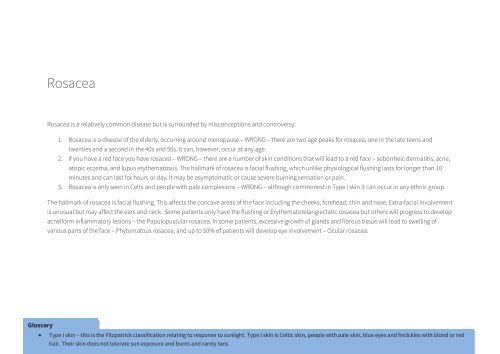Acne and Rosacea Charity Training Manual
Create successful ePaper yourself
Turn your PDF publications into a flip-book with our unique Google optimized e-Paper software.
<strong>Rosacea</strong><br />
<strong>Rosacea</strong> is a relatively common disease but is surrounded by misconceptions <strong>and</strong> controversy:<br />
1. <strong>Rosacea</strong> is a disease of the elderly, occurring around menopause – WRONG – there are two age peaks for rosacea, one in the late teens <strong>and</strong><br />
twenties <strong>and</strong> a second in the 40s <strong>and</strong> 50s. It can, however, occur at any age.<br />
2. If you have a red face you have rosacea – WRONG – there are a number of skin conditions that will lead to a red face – seborrheic dermatitis, acne,<br />
atopic eczema, <strong>and</strong> lupus erythematosus. The hallmark of rosacea is facial flushing, which unlike physiological flushing lasts for longer than 10<br />
minutes <strong>and</strong> can last for hours or day. It may be asymptomatic or cause severe burning sensation or pain.<br />
3. <strong>Rosacea</strong> is only seen in Celts <strong>and</strong> people with pale complexions – WRONG – although commonest in Type I skin it can occur in any ethnic group.<br />
The hallmark of rosacea is facial flushing. This affects the concave areas of the face including the cheeks, forehead, chin <strong>and</strong> nose. Extra-facial involvement<br />
is unusual but may affect the ears <strong>and</strong> neck. Some patients only have the flushing or Erythematotelangiectatic rosacea but others will progress to develop<br />
acneiform inflammatory lesions – the Papulopustular rosacea. In some patients, excessive growth of gl<strong>and</strong>s <strong>and</strong> fibrous tissue will lead to swelling of<br />
various parts of the face – Phytomatous rosacea, <strong>and</strong> up to 50% of patients will develop eye involvement – Ocular rosacea.<br />
Glossary<br />
• Type I skin – this is the Fitzpatrick classification relating to response to sunlight. Type I skin is Celtic skin, people with pale skin, blue eyes <strong>and</strong> fre3ckles with blond or red<br />
hair. Their skin does not tolerate sun exposure <strong>and</strong> burns <strong>and</strong> rarely tans



